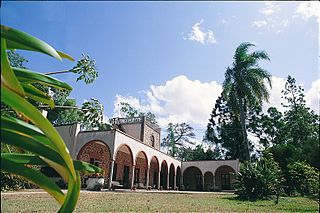Las Piedras may refer to:

Canelones is the capital of the department of Canelones in Uruguay. Its name is derived from a species of cinnamon, which is called "canelón", growing along the banks of the homonymous river. Since 2010, the city is also the seat of the municipality of Canelones.

Alcides Edgardo Ghiggia Pereyra was a Uruguayan football player, who played as a right winger. He achieved lasting fame for his decisive role in the final match of the 1950 World Cup, and at the time of his death exactly 65 years later, he was also the last surviving player of the Uruguay squad at the 1950 World Cup.

Bella Unión is a city in the north part of Artigas Department of Uruguay.

Las Piedras is a city in the Canelones Department of Uruguay. As of the census of 2011, it is the seventh most populated city of the country.

Club Atlético Juventud is a sports club based in Las Piedras, Canelones, Uruguay. CA Juventud won promotion to the Primera División Uruguaya to start in August 2007.
The Copa América de Futsal Femenina, branded as CONMEBOL Copa América Futsal Femenina and previously known as the Sudamericano de Futsal Femenino, is main women's national futsal competition of the CONMEBOL nations.
Las Piedras is a suburb of Bella Unión in the Artigas Department of northern Uruguay.

The Battle of Las Piedras was fought on May 18, 1811 as part of the Uruguayan struggle for independence.

Spain–Uruguay relations are the current and historical relations between Spain and Uruguay. There is community of 67,000 Spanish nationals residing in Uruguay and 33,000 Uruguayan nationals residing in Spain. Both nations are members of the Association of Spanish Language Academies, Organization of Ibero-American States and the United Nations.
Miguel Angel Lavié da Cunda, better known simply as Miguel Lavié, is an Uruguayan professional football defender who last played for Huracán F.C. in the Uruguayan Segunda División.
Juan Manuel Ferrari was an Uruguayan sculptor, born on Montevideo on 21 March 1874 and died in Buenos Aires on 31 October 1919.
Adolfo Justino Lima Camejo is a Uruguayan footballer who played as a midfielder.
Federico Platero Gozzaneo is a Uruguayan footballer who plays as a defender for Unión Española.

Viña Varela Zarranz is one of the oldest and most famous wineries of Uruguay, located in the city of Joaquín Suarez, Canelones. The Varela Zarranz family began their activities at the wine industry in 1933, a decade after the warehouse facility was built in 1888, by Diego Pons, who started the pioneer of the Uruguayan viticulture: Harriague, Vidiella, Varzi and Portal.

Estadio Campeón del Siglo is a football stadium located in Bañados de Carrasco, Montevideo, Uruguay, and the home ground of Peñarol, who plays in the First Division. It has a maximum capacity of 40,000.
The 2017 CONMEBOL Copa América Femenina de Futsal was the 6th edition of the Copa América Femenina de Futsal, the international futsal championship under FIFA rules organised by CONMEBOL for the women's national teams of South America. The tournament was held in Las Piedras, Uruguay, between 22 and 29 November 2017.

18 de Mayo or Dieciocho de Mayo is a city and municipality in the Canelones Department of Uruguay.
The Colorado Creek is a river in Canelones Department in Uruguay. The catchment area for the river includes 18 de Mayo, Cerrillos, La Paz, Las Piedras and Progresso. As of 2011, 108.038 people lived in the zone.
Álvaro Alejandro Fuerte Michetti is a Uruguayan football manager, currently in charge of Progreso.











